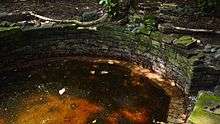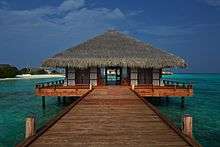Maamigili (Raa Atoll)
Maamigili is one of the inhabited islands of Raa Atoll in Maldives.
Maamigili | |
|---|---|
 Aerial shot of Maamigili Island | |
 Maamigili Location in Maldives | |
| Coordinates: 05°40′05″N 72°52′30″E | |
| Country | Maldives |
| Administrative atoll | Northern Maalhosmadulhu Atoll |
| Distance to Malé | 186.92 km (116.15 mi) |
| Dimensions | |
| • Length | 0.700 km (0.435 mi) |
| • Width | 0.500 km (0.311 mi) |
| Time zone | UTC+05:00 (MST) |
The island measures 750 meters in length and 500 meters in width for 100 hectares of pristine coral reef.
Maamigili can be reached via a scenic 45-minute seaplane ride from the capital Malé and through the new Irufu domestic airport which is 15 minutes away from the island by speed boat.
Loama Resort Maldives at Maamigili is a resort situated on the island. The resort maintains a collection of historical artifacts at Loama Museum, a nation’s heritage site with ancient baths and wells, and the Loama Art Gallery with contemporary local art.
Loama Museum

Loama Museum is the first and only Museum in a Hotel in Maldives licensed under the Government’s Department of Heritage. The young museum collection spans from the Classical to British Colonial Period. Highlights include artefacts found on the island, items of trade and livelihood from the Early Modern or Colonial Period (1514-1828) and British Colonial Period (1828-1965) and an Ancient Bath from the Classical Period (500 BCE-1153), Mausoleum foundations from the Medieval Islamic Period (1153-1514).[1] The museum is located at the hotel lobby and extends to ancient baths and a traditional house, which are located at the heritage site.
Notable exhibits include Chinese porcelain that could have arrived on this island during the Indian Ocean trade between South East Asia and the Middle East. Other interesting artefacts from the collection, representative of the lifestyle and trade that survived inhabitants of these coral atolls for centuries in the middle of the Indian Ocean, include grain measures, coconut oil making and lace equipment.
Vevu

Vevu (Dhivehi) or bathing tanks, were used as public baths and later for ablution. The actual period of this Vevu is unknown, however sandstone used in construction is evidence pointing to the pre-Islamic period (500BCE-1153AD). The symmetry of the two wells also suggest it may have been part of a temple. These types of baths are found in other parts of Maldives. Coral stone is also seen in some of the baths and mosques. This supports the theory that the Vevu was built earlier than most coral stone mosques.
amic period (500BCE-1153AD). The symmetry of the two wells also suggest it may have been part of a temple.↵These types of baths are) eory that the Vevu was built earlier than most coral a pre-Islamic coralstone structure.
As part of the museum exhibit, Loama Museum features a traditional Maldivian house on the resort. The house featured follows the traditions of South Asian architectural designs. According to oral history the house has existed in [[Kandholhudhoo (Raa Atoll)|Kandholhudhoo]j
Loama Art Gallery

Loama Art Gallery is affiliated with the National Art Gallery, Maldives, and shows contemporary art from the Maldives. It offers a platform for artists to exhibit and sell their work to local and international audiences. Contemporary art in Maldives has seen significant changes in themes and style over the last few decades.
As the only commercial art gallery in Maldives, it exhibits the works of famous artists of the Maldives along with the works of artists who are starting their career.
See also
External links
References
- Jameel, Mauroof.Historic Periods of Maldives